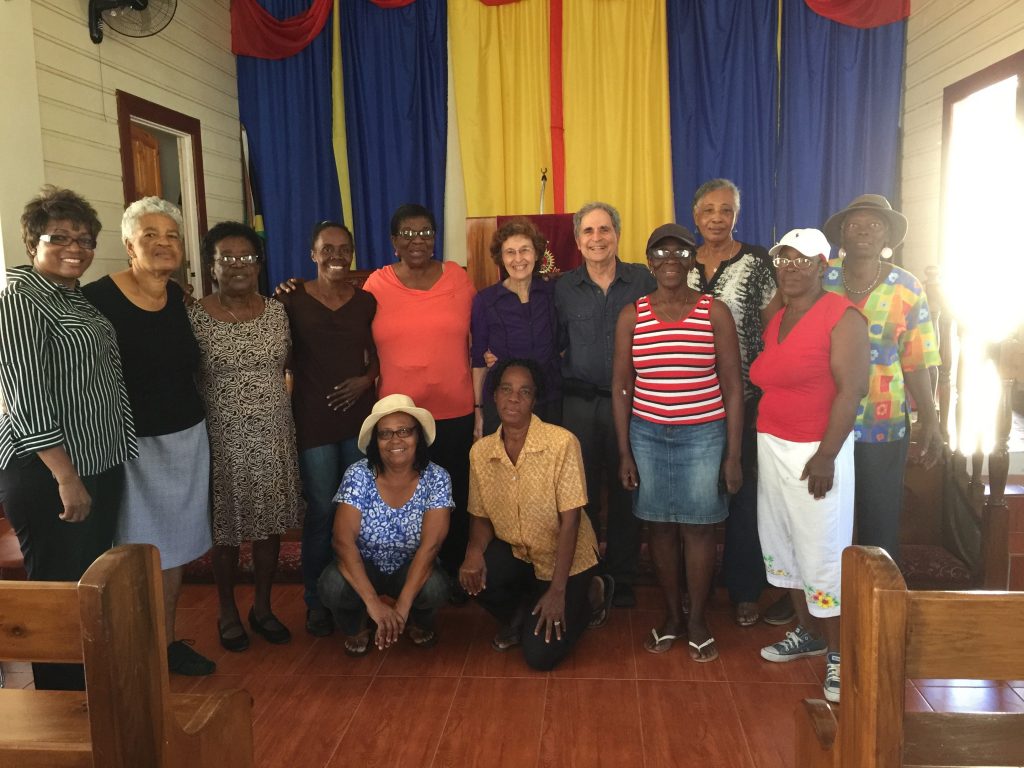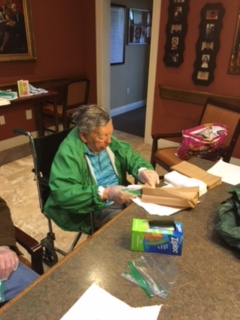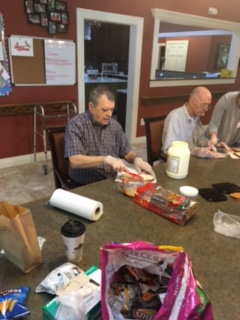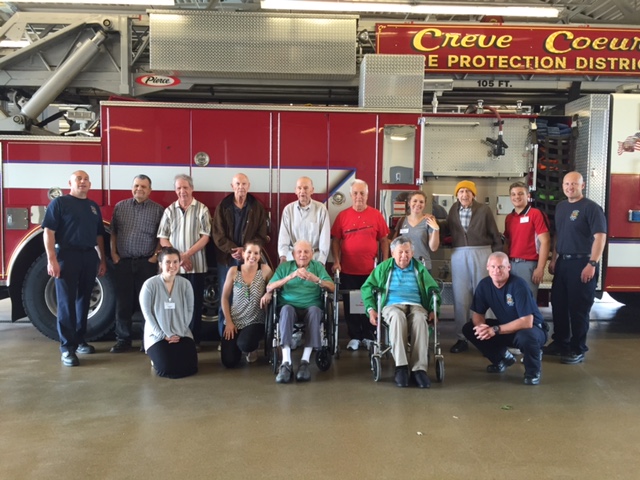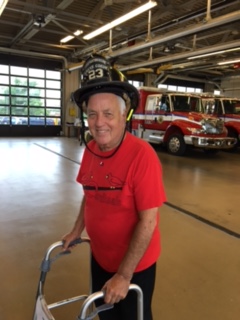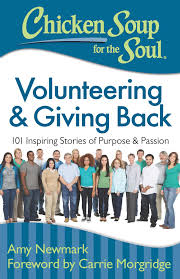Posts Tagged ‘caregiver’
Build Community Through Sharing Stories.
Just blocks from the bustling tourist shops in the port area of Falmouth Jamaica, stands a white stucco Salvation Army Church. Inside this building, we met with local community leaders. We shared stories and information, offering ways to stay connected throughout the dementia journey. We hoped to build community through sharing stories.
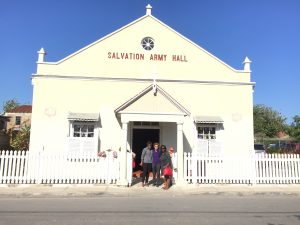
Even before we spoke, Shirley Duncan, a volunteer with Alzheimer’s Jamaica, and one of the event organizers, said, “I have a surprise for you.” She spoke eloquently of the need to talk about dementia, to share experiences, and to be there for the caregivers and people living with dementia. Then she told us that today’s participants were making a commitment to form an on-going group that would educate, advocate, and care for those affected by dementia in their community. “We are calling our group Debron, in honor of you two, because you are the catalysts,” she told us.
Ron had been working with Shirley and Dundeen Ferguson of Alzheimer’s Jamaica for several weeks, setting up the presentation. Shirley and Dahlia Klein orchestrated the details, spreading the word among the community leaders, garnering the venue, and making sure all went smoothly. We were thrilled to be catalysts and delighted to be discussing ideas with such a dedicated group of women, many of whom were former teachers.
 We shared ideas from Dr. Madan Kataria in Mumbai about the power of laughter yoga, and we told a story about creating an inland beach from, Dr. Claire Craig in Sheffield, England. We talked about the power of Dan Cohen’s Music & Memory program and discussed ways to connect through art, citing a story from Teri Miller in Houston, Texas. And we chatted about ways to stay connected through cooking together, sharing our own favorite childhood dishes, which included spiced shrimp, banana porridge, dumplings, roasted corn with shredded coconut, and so much more.
We shared ideas from Dr. Madan Kataria in Mumbai about the power of laughter yoga, and we told a story about creating an inland beach from, Dr. Claire Craig in Sheffield, England. We talked about the power of Dan Cohen’s Music & Memory program and discussed ways to connect through art, citing a story from Teri Miller in Houston, Texas. And we chatted about ways to stay connected through cooking together, sharing our own favorite childhood dishes, which included spiced shrimp, banana porridge, dumplings, roasted corn with shredded coconut, and so much more.
“We will spread these ideas throughout our community,” one of the women told us. “That is what teachers do, we share information.”
We left feeling so inspired and so connected. This is what we all need, caring people, compassionate and eager to learn, ready to offer help and hope.

###
During our presentation, we talked about Dr. Madan Kataria’s Ha Ha chorus. At the end, the women said, “We want to sing you a song.” They serenaded us with the Ha Ha chorus. Watch this video and please, sing along.
https://drive.google.com/open?id=0B0elXRV1YrIqUkhqNzN3RkhPSUU
For more about Laughter Yoga, visit Madan Kataria’s website, http://laughteryoga.org
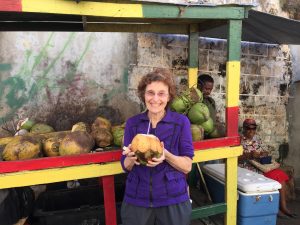
Deborah Shouse is the author of Connecting in the Land of Dementia: Creative Activities to Explore Together and Love in the Land of Dementia: Finding Hope in the Caregiver’s Journey.
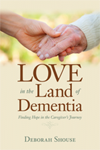
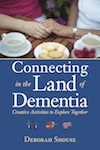
Tips from a Parisian Artist
 There’s something magical about visiting an artist in his studio. Especially if that studio is in Paris. We were honored to meet Patrick Laurin, artist and art therapist, on a recent trip to France.
There’s something magical about visiting an artist in his studio. Especially if that studio is in Paris. We were honored to meet Patrick Laurin, artist and art therapist, on a recent trip to France.
In the beginning, Patrick Laurin’s work with people who were living with dementia went slowly. When he first visited the care home and invited people to join him for painting, he heard various reasons the idea wouldn’t work. “I can’t hear you.” “I can’t see you.” “I can’t move my arm.”
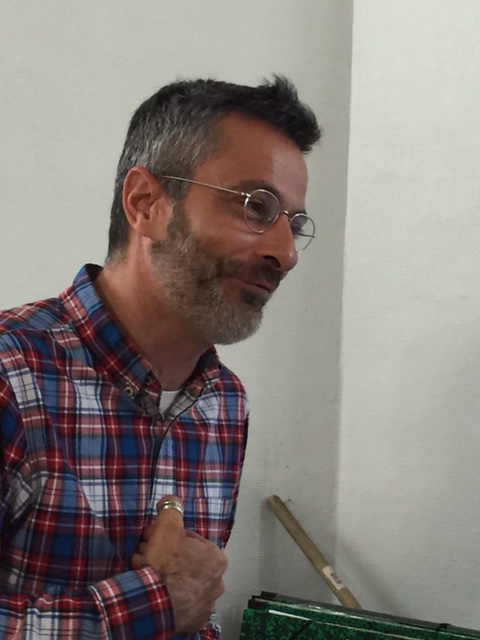 Patrick, who had quit working as researcher in the pharmaceutical industry so he could create deeper connections with clients, understood the importance of building relationships. Gradually, he got to know the people who lived in the community. He wanted to tailor an artistic experience specific to each person’s abilities and needs.
Patrick, who had quit working as researcher in the pharmaceutical industry so he could create deeper connections with clients, understood the importance of building relationships. Gradually, he got to know the people who lived in the community. He wanted to tailor an artistic experience specific to each person’s abilities and needs.
Over time, the people who couldn’t see, hear, or move were all happily involved in painting.
One woman seemed to blossom when holding the brush and stroking on the paint. Even though she couldn’t later remember to say, “I’ve been painting,” she enjoyed the experience.
One day, Patrick was on another floor in the care community when he encountered this woman and her daughter.
Her daughter said to Patrick,” You are the painter.”
Patrick was thrilled her mother had been able to mention the art therapy sessions. But before he could respond, the mother said, “No, the painter is me.”
“Inside, she was seeing herself as an artist,” Patrick says. “The painting strengthened her identity.”
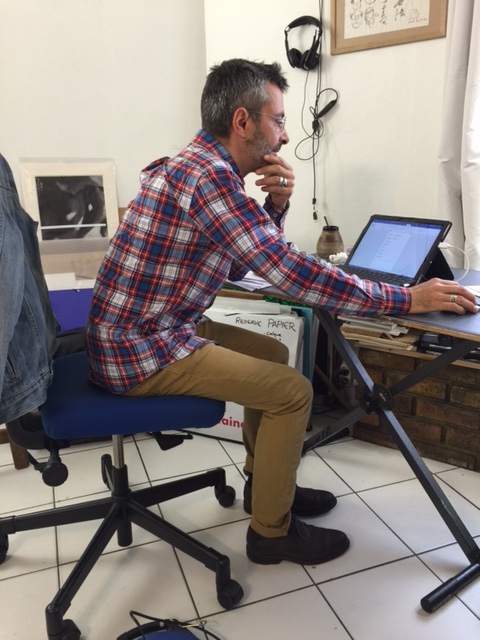 Patrick has learned to approach each person with flexibility. Sometimes Patrick jump starts his artists with a squiggle of color on the page. Then he steps back to let them respond with their own squiggle. If they’re stymied, he offers a choice of two colors.
Patrick has learned to approach each person with flexibility. Sometimes Patrick jump starts his artists with a squiggle of color on the page. Then he steps back to let them respond with their own squiggle. If they’re stymied, he offers a choice of two colors.
He also uses collage techniques to inspire his artists. He selects three separate pictures, each with one recognizable thing, such as a house, tree, or dog. He shows the photos to the artist, and asks, “Which one of these attracts you?” When the artist chooses a photo, Patrick then asks, “Where would you like to put this on the paper?” He and the artist apply paste to the paper.
“We don’t turn over the picture and apply paste, because the image then disappears and that can be confusing,” he says.
When the picture is glued to the paper, Patrick discusses a color that’s already in the picture.
“You could take the blue in the sky and extend it,” he might suggest. This suggestion often inspires the artists to start painting. If they get stuck, Patrick says, “What might look good near the house?” In this way, the painting expands.
For one woman, painting began as a series of colors and grew into a personal story.
She pasted a house and began expanding the lawn. Then she drew a bridge and weeks later, she added in a dog. At first, she was painting “a house, a bridge and a dog.” As the picture took shape, she said, “This is my house and my dog and this is the bridge we had to cross to get to the house.” The process of painting had loosened memories of her childhood home.
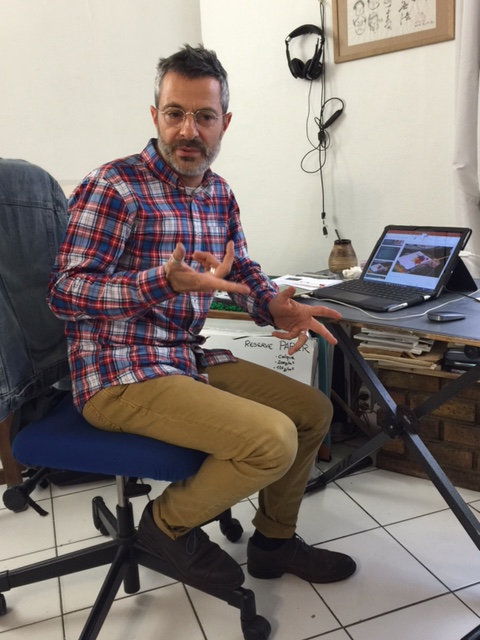 “When I share a piece of art by one of my students, I also share the story behind it,” Patrick says. “The act of creation is more important than the results.”
“When I share a piece of art by one of my students, I also share the story behind it,” Patrick says. “The act of creation is more important than the results.”
Tips:
Pick something that is easy for you, the care partner.
Put a point of color on the pages, then stand back. Offer support but don’t paint.
Enjoy the process and don’t get stuck on the results.
Thanks to Berna Huebner, founder of the Hilgos Foundation and co-producer of the documentary, “I Remember Better When I Paint,” for suggesting we meet with Patrick.
Get Cooking on Giving Back
The assembly line stretched around the spacious dining room table and each person focused fully on his task. One man spread mayonnaise on bread. Another placed turkey slices and another added cheese. Another slipped the sandwich into a baggie and others assembled the lunches, adding potato chips and a cookie. All worked diligently; there was a special purpose to this meeting of the Men’s Club at Dolan Memory Care Homes in Creve Coeur, Missouri. They were giving these homemade meals to the fire fighters in their community as a way of showing their appreciation.
Ten residents of varying abilities, including all levels of memory impairment, contributed to the sandwich brigade. Those who needed help had an assistant with them.
“The participating residents were filled with high energy and good spirits,” says Mary Kate Halm, LMSW, Admissions Coordinator of Dolan, who organized the activity. “They were excited to be engaged.”
The local fire department had invited the group to tour the station when they delivered the lunches. The experience included opening up the sides of the fire truck. One of the residents, who was usually indifferent to outings, used to be a tool designer. When he saw the tools in the fire truck, his eyes grew wide and he became very animated.
“Everyone enjoyed being engaged in a purposeful activity. They loved the tour and they asked excellent questions,” Mary Kate says. They wanted to know the details of their training, how much each truck cost, how much their equipment weighed, and more. The residents weren’t the only ones engaged.
“The firemen loved the attention,” Mary Kate says. “Plus, they were patient, communicated clearly, and were considerate of those in walkers and wheelchairs.”
The community volunteer activity generated a lot of joy and curiosity.
“They were completely connected to the experience,” Mary Kate says. “They were learning, they were giving back, and they were fully present. We created a moment of joy and that’s all that matters.”
Get ready to give back:
Mary Kate offers these tips for connecting with the community and giving back.
- Look for a service organization that you admire. This can be emergency responders such as fire fighters, police, sheriffs, EMTs, as well as animal rescue teams, cancer support organizations, and more.
- Find a project that’s fun for you and for the person living with dementia, a project you can both participate in. If you have friends and family who’d like to help, this is a great time to get others involved.
- Coordinate with the organization and find a time to deliver your gifts. If it’s of interest, ask for a chance to learn more about the organization.
For more interesting activity ideas, visit https://t.e2ma.net/message/gxreo/4bbql
Three Marvels of Misplacing
“These days I am constantly losing things,” a friend tells me. I understand, because I frequently misplace objects and even words!
“I don’t know where my glasses are,” Mom tells me. I bite my lip; she’s been misplacing things all day. We are supposed to be spending a day drawing and painting, trying to connect mom with the artist she used to be. We are supposed to bake cookies together and look through magazines. But I’ve been spending much of the time crawling around, looking under the sofa and chairs and between the cushions for the disappearing glasses.
“Let’s make our cookies. You won’t need your glasses for that,” I say.
“I need my glasses.”
As I search, I wonder when it became a drudgery instead of a joy to find things. One of my favorite childhood games was Hide ‘N Seek. I loved being the Seeker, loved the surprise of finding someone in a tucked away, mysterious place. I had a special trick I used when I was “It.” I would close my eyes and say, “If I were Dan, where would I hide?” Then an image floated into my mind and I’d race to the hiding place. Half the time, I was right.
Do I still have “it?” I close my eyes and think, “If I were Mom’s glasses, where would I be?” The refrigerator comes to my mind. I rush into the kitchen and fling open the refrigerator door, only to see the usual chaos. But I’m hungry, so I reach for an apple. Behind the fruit is a pair of reading glasses, sprawled across the shelf.
Triumphantly, I take the glasses to Mom.
“These feel nice,” she says.
Not only has my mother reminded me of the importance of creativity, curiosity and play, but she also discovered a great summer time tip: chill your glasses and cool off your face.
Deborah Shouse is the author of Love in the Land of Dementia: Finding Hope in the Caregiver’s Journey.
COMING SOON: CONNECTING IN THE LAND OF DEMENTIA: CREATIVE ACTIVITIES TO EXPLORE TOGETHER
Appreciating the Power of Love
“How long have you been together?” the younger couple asked Ron and me.
“Twenty-two years,” we answered.
“Wow!” they said. They’d been in love for seven months and our decades-long romance must have seemed exotic and slightly unbelievable.
“What are the secrets of a good relationship?” they asked. “Please share your wisdom.”
First, Ron and I basked in the idea that two people believed we possessed actual wisdom! Then we shared our insights.
How We Learned about Love
Our insights came from growing as individuals and as a couple during our wonderful long relationship and from earlier relationships that had helped us become our true selves. We also learned from watching our parents maintain their relationships in the face of dementia.
When Ron’s father Frank was in a memory care unit, Ron’s mom Mollie told her husband, “I love you so much.” Frank replied, “Not as much as I love you!.” Those were some of Frank’s last words and that sentence stayed with Mollie through and beyond her grieving.
During my growing up years, my father was circumspect in declaring his love for Mom. But when she slipped into dementia, Dad showed me what a true romantic he was. He treated her like he was courting her; he showered Mom with compliments and kisses and frequently he expressed his love for her. Even when she could no longer talk, she still enjoyed her favorite foods—he faithfully fed her sliced strawberries and chocolate candies.
Love Me Tender, Make Me Laugh, Always Have My Back
My parents were my role models and I also learn an enormous amount from the couples I interview every week for the love story column I write for the Kansas City Star Magazine. Here are some of the qualities people most love about their life partners and spouses.
Loves me just as I am
Takes care of me/Always has my back
Makes me laugh
Shares my values/ Complements me
Works hard/ Is honest and reliable
Always puts other people first/ Always puts me first
Inspires me to be better/ Appreciates me
Love Lights the Way
Some months ago, Oprah had author, visionary and cultural mid-wife Jean Houston on her TV show. “What do you wish people knew?” Oprah asked Jean.
“I wish people knew how powerful love is,” Jean answered.
That was one of the grandest lessons from my journey with my mom through her dementia: the power of love. Her love lasted all her life, far beyond her memory of things and people. Her love was a spark that lit up her life and mine.
An Insider’s Tips for Evoking Imagination
Molly Middleton Meyer pulls a red silk scarf out of her rolling suitcase and asks the group of 15, “What does this scarf have to do with springtime?”
A brief silence unfolds while people consider.
“I used to wrap a scarf around my head in the convertible,” one woman says.
The woman sitting next to her smiles. “Scarves blow in the wind,” she says.
Molly mimics the scarf wafting in a breeze.
“If the scarf was music, what kind of music would it be?” Molly asks.
“Jazz,” a man says.
“Rock and roll.”
“Classical.”
Molly, who has an MFA and is the creator of Mind’s Eye Poetry in Dallas, Texas, reaches into her suitcase and brings out a small watering can. She continues the relaxed pacing, asking for impressions, invoking imagination, creating a sense of comfort and connection for this group of people who live in a memory care facility.
After 20 minutes of creative play, Molly takes out a slim book and says, “Here’s a poem about spring that I really like. See what you think.”
She reads the short, rhyming verse and asks for reactions. She then invites the group to contribute to a writing project.
“There are no wrong answers,” she assures them. “I’ll ask something and you’ll say the first thing that comes into your mind. For example, when I say ‘springtime’ what flowers do you think of? ”
“Daffodil, tulip, roses…” the group offers.
Molly writes down each flower and reads it back to the group.
“We have our first line of poetry,” she tells them.
“Imagine where the flowers are, in a vase, in the garden?”
“What colors are they? What time of day is it?”
Every question invites imagination and word-by-word, the poem emerges. After they’ve created three short poems, Molly shows them a piece of art and asks, “What do you see?” She captures their observations and uses their words to create a poem.
Here’s an example of a poem segment created after looking at Oriental Poppies, Georgia O’Keefe’s painting of two large orange poppies.
I see two evening gowns
on a diagonal, flowing.
I see a Scottie dog
prancing in a field of orange.
I see summertime in Santa Fe.
I see a black bird soaring into sunset.
“When I read back their words and say, ‘You all just wrote this,’ it’s very empowering,” Molly says.
For those at home who want to have a session of creative imagining, Molly has these suggestions:
Gather a few interesting objects, such as a recipe book, a nature photo, a pot holder, and one at a time, show them to your partner and ask, “Mom, what do you think about when you see this recipe book?” Give her plenty of time to respond and jot down her answers. If she asks, “Why are you writing?” tell her, “I value what you have to say.”
Soon, you’ll have a collection of words and phrases. You can take a photo of the object along with the poem it inspired and put them together in a book. #
Molly Middleton Meyer is the founder of Dallas-based, Mind’s Eye Poetry. To date, she has facilitated over 600 poems written by people with dementia. Mind’s Eye Poetry has been featured in U.S. News and World Report, the Huffington Post, the Dallas Morning News, Affect Magazine, Growing Bolder Magazine, and on NPR. When Middleton Meyer is not facilitating poetry, she writes her own. Her first book of poetry, Echo of Bones was published in 2014. For more information, contact Molly Middleton Meyer, M.F.A. Poetry Facilitator/Speaker at www.mindseyepoetry.com
Deborah Shouse is the author of Love in the Land of Dementia: Finding Hope in the Caregiver’s Journey.
Six Tips for Surviving the Holiday Season When a Loved One Has Dementia
Normally, Thanksgiving was my favorite holiday, a time our family gathered together at my Kansas City home. But that November, my stomach clenched at the thought of our traditional Thursday evening meal.
My mother had Alzheimer’s and the holiday would be different. I felt alone but of course I wasn’t: there were 15 million family/friend caregivers helping the five million Americans who have dementia.
I’d been through my initial storm of denial and grief. I felt I’d been coping well with Mom’s diagnosis, focusing on offering my father extra support and trying to flow with Mom’s now spotty memory and personality quirks. But a pre-season sadness invaded me in October and I found myself dreading the alleged festivities. How could we have our usual holiday dinner, take our after dinner walks, play Scrabble and Hearts and Charades without Mom’s participation? How could we enjoy going to movies and plays when Mom was having trouble focusing and sitting still? And how would Mom react to the situation: would she feel uncomfortable and out of place? Would Dad feel protective and anxious? And more important, what would we have for dessert! Mom was legendary for her chocolate and butterscotch brownies, date crumbs, and bourbon balls. No store-bought cookies would compare.
As I stewed over the prospect of a depressing Thanksgiving weekend, I remembered the vows I had made: I had promised I would try to stay connected to Mom throughout her Alzheimer’s journey. And I had promised to see the gifts and blessings and fun in the experience.
So I began thinking: if the holiday is going to be different, why not concentrate on making it different in a creative and connective way? Here are some ideas I used to make the holiday work for me.
- Acknowledge my feelings of loss and grief. I wrote them down and shared them with a few friends. Just expressing myself made me feel stronger.
- List what I would miss most during the holiday season. My list included cooking with Mom, eating her brownies and rum balls. I asked my brother, who’s a terrific baker, to make some of our favorite sweets and I set up a place in the dining room where Mom could sit next to me while I chopped mushrooms and peeled potatoes.
- Create an activity to give our holiday a new focus. We created a simple holiday scrapbook called, “The Little Kitchen that Could,” complete with a family photo shoot and a playful script.
- Appreciate my blessings. We started our Thanksgiving meal by asking everyone to name one thing he or she was grateful for. I continued my gratitude practice throughout the holiday season, either alone or with others via telephone and social media.
- Take extra good care of myself. I treated yourself as I would a friend who’d suffered a deep loss.
- Set up a lifeline. “I’m worried about melting down,” I told my friend. She urged me to call anytime for encouragement and reassurance.
These six steps helped me enjoy my holiday and appreciate my mom just as she was. Our holiday was “different” but it was also wonderful.
Deborah Shouse is the author of Love in the Land of Dementia: Finding Hope in the Caregiver’s Journey.
Setting the Table with Memories
Imagine sitting down for your favorite growing up meal. The sight, taste, and aroma of those hallowed childhood dishes would stir up a cornucopia of delicious memories.
Recently my friend Elizabeth cooked such a meal for her husband Charlie, who is living with early onset dementia. Charlie grew up in the 1950s, so Elizabeth bought a period cookbook. She and Charlie read through the recipes to see which ones he resonated with.
“I will cook your favorites and we’ll invite a couple of your old friends from high school over for dinner,” she told him.
Elizabeth is a terrific cook and Charlie loved this idea. They analyzed the potential entrees, Beef stroganoff, chicken Cacciatore, meatloaf, but Charlie kept returning to one page: the recipe for Johnny Marzetti Casserole.
At first, Elizabeth demurred. As an accomplished cook, she didn’t like the idea of serving guests such a simple meal. But Charlie was persuasive, so she bought ground beef, canned tomatoes, cheese, and elbow macaroni. She cooked up a big pan of Johnny Marzetti, otherwise known as goulash, American Chop Suey, or macaroni and beef.
Charlie and his friends went wild over the food and laughed as they shared memories of school, the neighborhood, their families, and favorite foods. The cookbook, the meal, and the cook were a huge success.
Next on Elizabeth’s list: take pictures of Charlie with his favorite dishes and paste them in a scrapbook along with the recipes.
What are some of your favorite childhood meals?
For me, the desserts were most important. I adored cream horns, Mrs. Smith’s Lemon Icebox Pie, and Mom’s brownies and chocolate cake, particularly the icing. We still include Mom’s memorial brownies, courtesy of my brother, Chef Daniel Barnett, at family gatherings.
Deborah Shouse is the author of Love in the Land of Dementia: Finding Hope in the Caregiver’s Journey.
Doing the Work of Our Hearts
I woke up in the middle of the night with the answer I’d been seeking: I would self-publish the book of essays I had written about my journey through my mother’s Alzheimer’s and I would donate all the monies from the book to Alzheimer’s research and programs.
It was the summer of 2006, and for weeks I’d been wrestling with a question:
Should I seek a traditional publisher or independently produce the book? Both seemed daunting; in the past, I had primarily written books for and with other people and publication wasn’t my problem. But this book, Love in the Land of Dementia: Finding Hope in the Caregiver’s Journey, was the work of my heart, born out of my desire to stay connected with my mother and find the joys and blessings in her experiences with Alzheimer’s. I wanted to share my stories of hope so they might help other caregivers.
“What about donating a portion of the proceeds?” my partner Ron asked. I was already making a marginal living; Ron’s suggestion was practical but I shook my head.
“I think I’m supposed to donate it all,” I told him. “That way, instead of selling a book, I’ll be raising money for a cause I’m passionate about.”
I talked through the details, consulting knowledgeable friends, an attorney and our local Alzheimer’s Association. My mission: to use the book as a catalyst to raise $50,000 for Alzheimer’s. There was one glitch; I estimated the cost of designing and printing could be in the thousands. Where would I get the money? But even though I was often worried about funds, this hurdle didn’t bother me. My intuition was strong. I was supposed to do this and would raid my savings if needed. Ron was excited about the project and pledged to work with me and help me make it happen.
“We will also help you,” my friends Rex and Jane said. They had shepherded several books through production and were extremely savvy. Plus, they wanted to be part of my mission.
Over the next months, Ron and I spent hours with Rex and Jane, working on design, cover, production and print details. Endlessly patient, they were dedicated to creating the book I envisioned. And they kept their fees to a minimum.
When the finished product arrived months later, I felt a sense of pride and completion. The beautiful cover featured one of my mother’s paintings, the type was easy to read, the interior design inviting.
Ron and I had often performed my stories together, and we began speaking and sharing stories from the book with Alzheimer’s associations, healthcare professionals, caregivers’ groups and others. When we traveled, we reached out to Alzheimer’s groups to set up speaking engagements. We were always moved and inspired by the people we met.
“The person with Alzheimer’s is the pupil in God’s eye,” the priest in a fourteenth-century church in Florence, Italy told us.
“Your story is my story,” a man in Istanbul, Turkey said.
“I’ve been caring for my mother for ten years,” a woman from Brooklyn, New York said. “It has been the most meaningful experience in my life.”
“When I learned Mama had dementia, I quit my job in Houston and moved back home,” a woman in St. Thomas, Virgin Islands said. “I wanted my children to know their grandmother in all the stages of her life and I wanted to be here to care for her.”
Sometimes we spoke in front of hundreds of people; other times we talked to groups of ten. When possible, we brought books and people often donated more than the suggested fifteen-dollar price, knowing that all the proceeds went to Alzheimer’s research and programs.
By 2011 we had done it! We had raised $50,000 for Alzheimer’s. But we kept going; we were still learning and growing. The work was healing for both of us and we loved connecting with other caregivers.
In 2012 I was ready to give the book a wider distribution and reached out to Central Recovery Press. They published an enhanced edition in 2013. Today, our fundraising journey continues as we donate a portion of our proceeds to this important cause.
The self-published version of Love in the Land of Dementia served as a catalyst for raising more than $80,000 for Alzheimer’s programs and research. My stories of looking for the blessings in the journey reached thousands of people, fulfilling my goal of making a contribution to the world. And the bonus was that both Ron and I had changed.
By following our intuition and doing the work of our hearts, we became more compassionate, understanding and trusting.
by Deborah Shouse
Fringe Forward with this Edgy, Engaging, and Evolving Theater
For Deb Campbell, Executive Director, Kansas City Senior Theatre, the playwriting process starts with deep listening. When she decided to create a play about dementia for the Kansas City Fringe Festival, she turned to her colleague and friend, Johnna Lowther, for inspiration and support. Together they began a creative exploration by gathering groups of care partners and people with dementia. Deb designed group activities to get everyone connected to each other and to the topic.
Ron and I were honored to participate in one of Deb’s listening groups.
“Choose a word,” she tells us and we select a word from a tumble on the table. Then she asks each person to add their word onto a magnetic board and tell us why they picked it.
One man chooses “apparatus.” He explains, “I’ve worked with tools most of my life. Since the Alzheimer’s, I can’t trust myself. I’ve put the tools away.”
One man selected ‘gorgeous’. “My wife, Annie, loved that word. She described everything as gorgeous, her engagement ring, flowers, a teacup, a bedspread. Everything was gorgeous to Annie. She was gorgeous to me.”
The stories around the words have us leaning forward in our chairs. Deb draws us further into our own stories. She asks us to select from a pile of masks, then invites us to put on the mask and speak.
“Don’t forget the real me,” one person says.
“I’m not trying to hide,” says another.
We all have a turn holding a steering wheel.
“If you were driving this play, where would you take it?” Deb asks.
“In reverse,” a woman says. “I feel like that’s the direction I’m going.”
“My wife keeps getting lost,” a man says. “I now have to take the wheel.”
After the listening sessions, Deb reaches out to people to see if they’d like to share additional stories. She then meets them at their homes to record what they have to share. The stories are transcribed exactly as they are told.
“I’ve learned I can’t hurry the process,” she says. “I just let the stories flow in.
Once Deb has collected all the stories, she begins to hone in on the play.
“I become obsessed,” she says. “I devour the material, slosh around in it, and immerse myself. I feel overwhelmed, yet I trust the process.”
She plans to let the play unfold organically. Her job is helping people reveal their experiences. She won’t shape the drama until the theme emerges from her collection of powerful personal stories.
Originally, she used an image of her mother-in-law’s gnarled hand holding onto her baby grandson’s hands. She thought the play’s theme would be “Hold On.” But as she listened to stories and collaborated with Johnna, she realized the play is about accepting the present instead of holding on to the past. An image of building blocks burst into her mind. Those blocks, once again marked with words, now anchor the play, which is titled, Seven Stages, Seven Stories.
The play will debut July 18 at 7:30 during the KC Fringe Festival and will play several times during the festival. The cast is a mixture of people with early onset dementia, care partners, storytellers, and experienced actors.
Ideally, audiences will be inspired by the depth and complexities of the people who are living with this disease and by the love and connections inherent in the journey.
Treat yourself to a meaningful theater experience. Come to Phosphor Studio 1730 Broadway Blvd. (across the street and south of Kauffman Center).
Saturday, July 18th 7:30
Tuesday, July 21st 6:00
Thursday July 23rd 6:00
Saturday, July 25th 4:30
Visit the Fringe website to get tickets and for any changes in scheduling: www.KCFringe.org
Visit Kansas City Senior Theater for more about Debra’s work:
Deborah Shouse is the author of Love in the Land of Dementia: Finding Hope in the Caregiver’s Journey.
